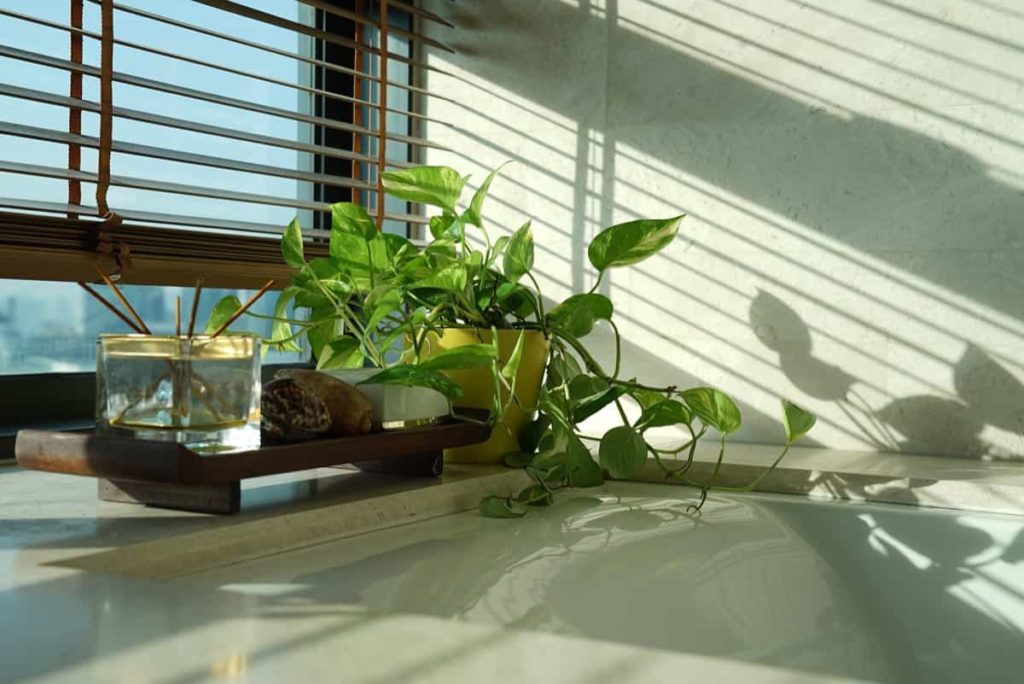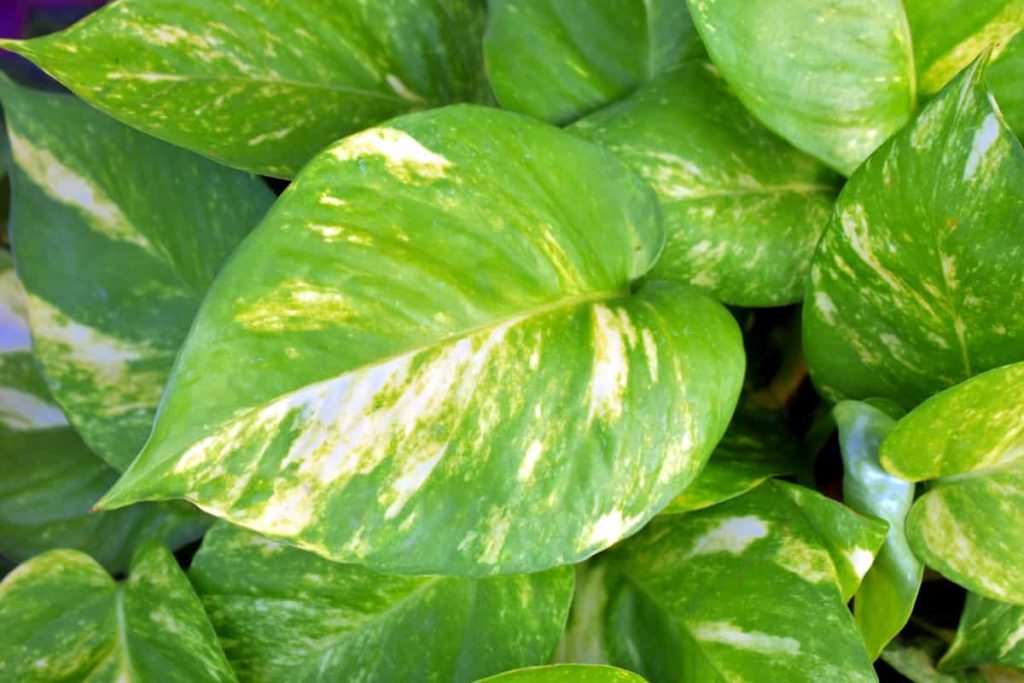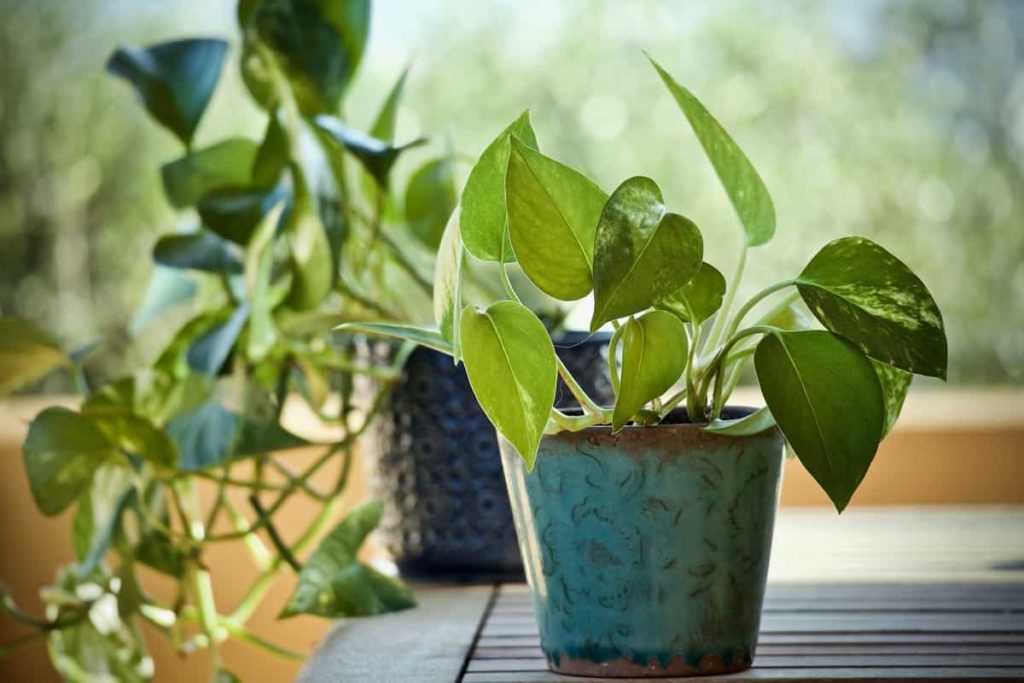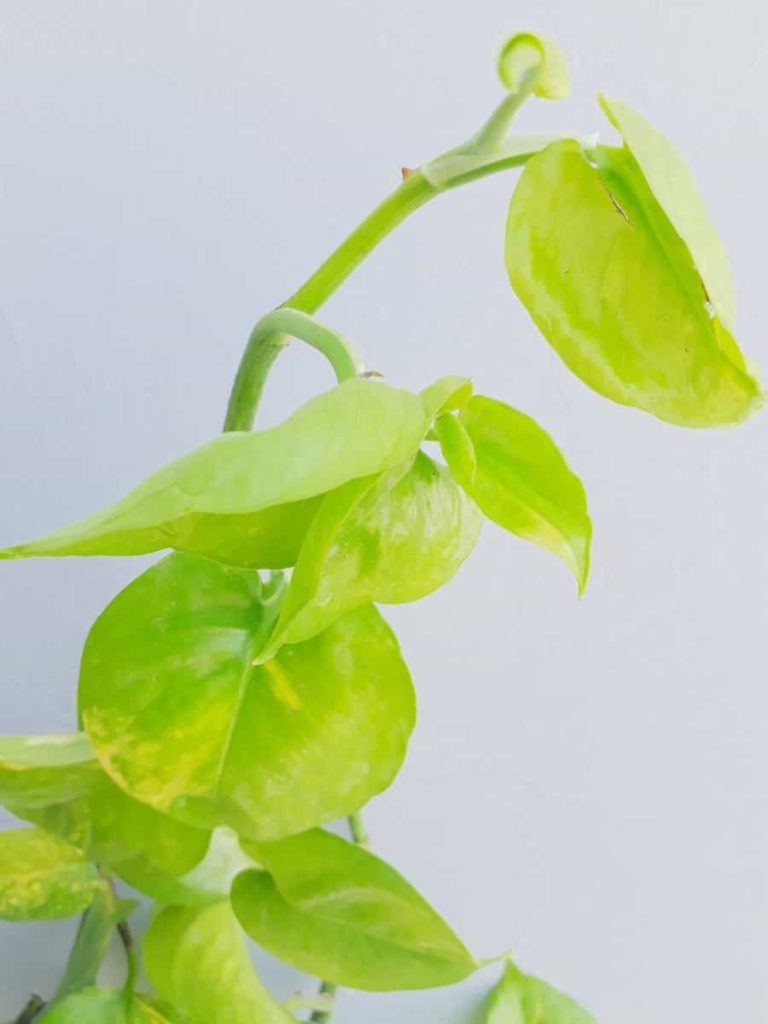Pothos is an evergreen plant with thick, waxy, green, heart-shaped leaves with yellow spots. As a houseplant, it is commonly grown as a hanging plant. Pothos can climb by aerial roots, and wild or cultivated plants grown outdoors can reach great heights using tall trees as supports. Pothos has several common names, including golden Pothos, hunter’s cloak, ivy arum, devil’s ivy, money plant, and taro vine.

Pothos plants are among the most common and popular houseplants, known for their glossy foliage and trailing growth habit. They are low maintenance and can be grown in various ways—from hanging baskets to tabletop planters to vertical gardens.
How to Propagate a Pothos
When to propagate Pothos?
You can propagate Pothos cuttings at any time during the year, but they may take longer to root in the colder months. Most gardeners do this after harvesting in the spring and summer seasons. If you want to divide them, it’s best to do so in the spring to give the new plants enough time to get established in the summer.
Types of Pothos
1. Golden Pothos: The Golden Pothos is probably the most popular species found in garden centers, and for a good reason. Golden Pothos is most effective at removing formaldehyde from the environment. This substance is present in most homes because it is released from many building materials, such as foam insulation, paint, and varnish.
2. Jade Pothos: Jade Pothos has uniform dark green leaves free of pigmentation that may have benefits. This Pothos subspecies thrives best in low-light conditions, making it perfect for homes and apartments that don’t get a lot of natural light.
3. Neon Pothos: Neon Pothos leaves make it easy for you to distinguish this variety from other Pothos species. With their bright chartreuse green color and lack of variety, these vibrant and vibrant plants are sure to brighten up the darkest corners of your living space. Neon is a bright variety; this Pothos requires low light and is perfect for brightening up a dark area of your home.
4. Silver Satin: This variety has dense gray-green leaves with silver dots. It is tolerant of drought and low light conditions. Satin Pothos is so called because its dark green leaves are sprinkled with silvery gray, giving it a satin-like sheen. Satin Pothos leaves are also large and heart-shaped, making them a popular addition to houseplant nurseries. To maintain the unique variation on satin Pothos leaves, leave the plant in bright, indirect light.
In case you missed it: Growing Money Plant in Pots, Indoors, Balcony

Tips for planting Pothos
- It is one of the easiest house plants to grow. For best results, ensure that it has favorable and mild conditions for growth. Plant Pothos in average potting soil. Feed houseplants monthly with a liquid fertilizer.
- Water well and allow it to dry out completely between watering. Moisten the pot by placing it on a gravel tray that you fill halfway with water. Pothos grow best and have the best leaf color in bright indirect light. Although it tolerates low light, it can lose contrast. Solid green foliage cultivars are best for low-light areas.
- Pothos are not heavy feeders; when using Rolling Nature potting mix, feed the plants with an organic fertilizer every 6 months. Feed bi-monthly for normal soil, with any balanced houseplant organic fertilizer.
- Plant pruning can control the shape or size of your plant. Cut a leaf about 2 inches from the base of the plant to maintain the new growth. Remove old yellow leaves.
- If the Pothos plant has strong growth and seems to be outgrowing the pot, it’s time to repot. After a year, you can repot in a 1 or 2-size container with fresh soil and compost. It also helps to re-trim the plant at this time. Grow Pothos indoors, preferably in bright, not direct, light, although it will tolerate low-light conditions. Lighter leaves mean more sun and less varietal damage. Pothos likes its soil to dry out between waterings and accepts irregular watering maintenance. It dislikes wet roots.
- Leaves drop when the plant is thirsty and needs to drink. But don’t let this wilting stage go too long, or you will start to see leaf drop.
- Pothos perform well in various lighting conditions and are a great option for low-light homes. When watering the plant, Pothos do best when their soil is allowed to dry out between watering. As with any plant, look at the leaves for signs of the plant’s well-being. The plant is happy if the leaves are shiny, green, and plump. If they’re turning brown or wilting, you’re not watering enough. Do not keep the soil constantly wet.
- Although Pothos plants aren’t prone to insect infestations, keep an eye out for mealybugs. These small, white bugs like to eat Pothos leaves and usually leave a waxy and powdery residue. If you encounter these pesky creatures, treat your plant with neem oil or soak a cotton swab with alcohol and wipe the plant clean.
Temperature and humidity for growing Pothos
Pothos should be kept consistently above 10°C, although they most appreciate a normal room temperature that hovers between 18 and 23°C. Additionally, Pothos plants like high humidity. You can increase the humidity around the Pothos plant by placing it in a typically humid area of the house. Pothos plant is very tolerant and can thrive in low-humidity environments, so there’s no need to invest in a humidifier.
Difference between Pothos vs. Philodendron
They are both vines that look the same. The main difference is that Pothos have large, thick leaves and ribbed stems. Philodendron leaves are darker and less likely to be variegated. But, they have similar water, light, and maintenance requirements.
Propagating Pothos by cuttings
Propagation of Pothos is also easy from cuttings. Place a cut stem with a node in a glass of water and wait for it to root. Then plant it in a small container. Once your Pothos plant is big enough, you can make new plants and gift them to your friends and family or add them to other rooms in your space. It is best to use stem cuttings from the mother plant to create a new plant. Pothos propagation is easy when done using stem cuttings. Pothos cuttings like to propagate in water first. Here are the steps to take:
In case you missed it: Exotic Herbs Farming in India: A Growing and Production Guide for Beginners

- Using a sterile, sharp cutting tool, select a healthy stem with at least three leaves, and cut it at an angle about a half inch or inch below the lowest leaf.
- Remove the bottom leaf from the plant stem (you don’t need to remove the other leaves).
- Place the stem in a water jar, but do not let the rest of the leaves touch the water.
- Once the cutting has sprouted new roots several inches long, possibly within a few weeks, transplant it into a pot of potting soil as soon as possible so it can begin to develop a strong root system.
- Locate the pot in a spot with indirect light and keep the soil moist but not wet.
How to propagate Pothos by division
Dividing root balls is a great way to get bigger plants quickly. Depending on the plant size, you can divide it into 2 or more sections. Below are the steps to propagate Pothos by division. Before dividing Pothos, ensure it is well hydrated. Water the plant deeply 24 hours before you plan to divide it.
- Step 1: Prepare new containers – Choose containers with good drainage and partially fill them with pre-moistened potting mix.
- Step 2: Remove the root ball – Carefully lift the entire plant out of the current pot. If it’s tightly packed in the pot, tap the side of the container, or slide a knife around the inside edges to loosen it.
- Step 3: Tease the roots – Break off excess soil and tease the roots, separating the pieces where there is a natural gap between the sections. You may want to use a sharp, sterile knife or pruning shears to cut stubborn roots.
- Step 4: Pot up the divisions – place the divisions in the prepared pots at the same depth as they were before, and fill the soil around them. Pack it gently to remove any air bubbles.
- Step 5: Water your new beginnings – moisten them lightly until you see them begin to ooze through the drainage holes. Let any excess drip off, and place your new plants in a warm, bright spot out of direct sunlight.
How to propagate Pothos in Sphagnum Moss
Finally, Pothos can be easily propagated in sphagnum moss. Some growers experiment with using sphagnum moss for other plants and prefer this medium.
1. Soak the sphagnum moss – Sphagnum moss is often purchased dry, so it will need to be soaked and rehydrated for 20 to 30 minutes before being used for spreading. After that, fill a bowl with water and submerge the moss completely. Set it aside while you complete the rest of the steps.
2. Take stem cuttings – Using sharp, sterile scissors or shears, take a stem cutting from your mother plant. Each cutting should have at least 3 to 4 nodes. Nodes are small bumps along the stem where leaves and aerial roots grow. They are also where new roots will grow on the cuttings.
3. Remove the bottom leaves – Remove the bottom leaves from each cutting, leaving at least 1 to 2 leaves on top. You can cut off the leaves or gently pull them off the stem.
4. Place the cuttings in the moss – Once the moss has finished soaking, remove it from the water and wring it out to remove as much water as possible. The moss must be moist but not soggy when finished. Add a small amount of sphagnum moss to glass, plastic container, or vase, and then place the cuttings in the moss.
The bottom of the stems with exposed nodes should be completely covered with moss, while the rest of the leaves sit on top of the moss. Gently press the moss around the cuttings, securing them and ensuring the moss is touching the cutting nodes.
5. Keep the sphagnum moss moist – Place the cuttings in a location that receives bright, indirect light and keep the sphagnum moss evenly moist. Roots will take a few weeks to grow, and it’s important to keep the moss moist (but not soggy) the entire time.
6. Plant the rooted cutting in the soil – Once the cuttings are rooted at least 2 to 3 inches long, they can be planted in the soil. It will take a few weeks but could take up to a month. Use a well-draining potting mix and plant the cuttings in a small pot with drainage holes. Water the freshly potted plant well and return it to a bright, indirect light location. Keep the soil evenly moist for the first two weeks to help the roots acclimate to the soil.
In case you missed it: Top 14 Mini Tractors to Improve Farm Production in India

Propagation of Pothos cuttings in water
- Use a sharp, sterile blade and cut the Pothos vine ½ inch above and below the growth node. For a bushy Pothos plant, take at least three cuttings per pot.
- Then, fill the glass halfway with room temperature water.
- Place your Pothos cuttings in the glass, ensuring the growth node is submerged but the leaves remain above the water’s surface. Store your glass cuttings in a warm, bright room without direct sunlight. Change the water in the glass once every 5 to 7 days to prevent algae and bacteria build-up.
- After 7 to 10 days, the cuttings will sprout roots. Wait until the roots are at least 2 inches long or another 3-4 weeks. Next, transplant your rooted Pothos cuttings into a well-draining, loamy soil mix, and water them well.
Pothos propagating problems and solution
Yellow Leaves: This could be due to the water you are using. Chlorinated water or fluoridated water can cause the yellowing of leaves. Try changing the water to rainwater /filtered water. Otherwise, you can allow the tap water to sit in the pot overnight and use the top 3/4 of the water for the plant. The likely cause is overwatering, so the treatment is the opposite of what you’re doing, which is watering too little and maintaining the amount in the care instructions.
Dry brown leaf tips: You will notice that the room is very dry. Misting the Pothos plant leaves will improve humidity and prevent the leaves from drying out.
Black leaves or sudden dropping of stems or plants: Possibly a sign of overwatering and root rot. Cut off affected branches. Allow the soil to dry completely and allow new roots to develop. In severe cases, plants may not recover.
Cut, yellow, wilted, or brown edges on leaves: This can signify waterlogging. Add water as needed.
Cuttings are not rooting: There are several reasons why your Pothos cuttings may not be rooting: The cuttings are not growing. You can’t propagate Pothos from just one leaf, so always ensure the cutting has a node. The cuttings are not getting enough light. Please place them in a room with bright, indirect light but away from the strong midday sun.
The cutting is too long. Try using single-node cuttings or vines smaller than 6 inches instead. It’s too early. Pothos cuttings take 1 to 4 weeks to start rooting. They will root quickly in water, and if you propagate them during the spring and summer.
Cuttings are turning black: Pothos cuttings can be susceptible to stem and root rot, which causes them to wilt and turn black. If spreading in water, change the water once every five days. For soil spreading, use a well-draining potting mix, and allow the top half inch of soil to dry out before watering again.
In case you missed it: How to Start Exotic Fruit Farming in India: A Production and Growing Guide for Beginners

Water-to-soil transfer method for growing Pothos
- Transferring rooted Pothos cuttings from water to soil can take some time and care. Plants may prefer to stay in the same medium you planted them in. Sometimes transplanting cuttings from water to soil can be a bit difficult. Try not to panic if the cuttings show signs of stress, such as fallen leaves or leaves turning yellow.
- After propagating the Pothos in water, prepare the cuttings for planting if you want to grow them in the soil. You may need to create a low-pressure transition between the water and the soil.
- Add a little soil slowly at a time to the water. Add a little more soil every few days or up to a week.
- Give the Pothos time to adjust each time you add more soil. Soon, the container should have the consistency of more soil than water. Continue until you reach a firm mix.
- Once the mixture resembles real soil, it’s time to transfer the cuttings to their desired container. Add some soil first and then transfer the contents of the original container to the new one. Fill the rest of the pot or basket with soil.
- Water a bit and check daily to see if your Pothos is acclimating to its new home.
Frequently asked questions about propagating Pothos (FAQ)
Can you grow Pothos from cuttings?
The main option is to start Pothos plants by rooting cuttings in water or soil. The difference is that water-started plants develop roots more quickly, but the resulting roots are not as well adapted to living in the ground when you transplant them. They will take a little longer to establish.
Can you propagate Pothos in winter?
You can propagate Pothos in winter, but the process may take a little longer. I would recommend waiting until the warmer months for the best results.
Why are my Pothos propagation roots turning brown?
Pothos root rot can result from overwatering or fungal infection in the soil. Rotten roots will turn brown or black and feel soft. Bad roots must be cut off; the plant should be repotted in a sterile mix.
Should I misty my Pothos?
As a rule of thumb, no. Pothos generally do not need misting. To increase humidity around the Pothos during the winter, you may want to plant the plant on a stone tray. Misting the plant won’t help keep it properly watered or moist and may increase the plant’s risk of insect attack.
Do Pothos plants need full sun?
Pothos do best in moderate indoor light but can survive in various light conditions, including low light. Outdoors can be grown in the shade to partial shade. Wherever you decide to display your Pothos, be sure to avoid direct sunlight.
Does Pothos need big pots?
Pothos rarely need repotting and can be grown in a small pot, which helps prevent the plant from getting too big. Generally, a new pot must be no more than 2 inches larger than the old pot. A 10-inch deep pot provides plenty of room for the plant to grow.
In case you missed it: Best Place to Buy Plant Seeds Online in India: For Vegetables, Flowers, Fruits, Herbs, and Hybrid Seeds

Why is my Pothos dying after repotting?
Pothos dying after repotting is usually caused by the potting soil retaining too much moisture. Pothos needs well-drained soil and does not tolerate permanently wet soil. If the soil is too wet after replanting Pothos, the leaves will droop, wilt, and turn yellow due to root rot.
Conclusion
Pothos are easy-care, easy-to-find hanging indoor plants that come in various leaf colors, patterns, and sizes. There’s a quick, cheap, and easy way to get more houseplants. This early-friendly vine is a prolific grower and will benefit from regular trimming. Propagating Pothos is extremely easy. It is one of those plants you can pinch off a leaf and a node and give to a friend. If they stick it in water or soil to root, they will soon have a Pothos plant. Pothos can also be easily divided when repotting to produce new plants.
- Types of Pesticides Used in Agriculture: A Beginner’s Guide
- Economical Aquaculture: A Guide to Low-Budget Fish Farming
- 15 Common Planting Errors That Can Doom Your Fruit Trees
- How to Make Houseplants Bushy: Effective Tips and Ideas
- Innovative Strategies for Boosting Coconut Pollination and Yield
- Pollination Strategies for Maximum Pumpkin Yield
- The Complete Guide to Chicken Fattening: Strategies for Maximum Growth
- Natural Solutions for Tulip Problems: 100% Effective Remedies for Leaf and Bulb-Related Issues
- Revolutionizing Citrus Preservation: Towards a Healthier, Greener Future
- Natural Solutions for Peony Leaf and Flower Problems: 100% Effective Remedies
- Maximizing Profits with Avocado Contract Farming in India: A Comprehensive Guide
- Natural Solutions for Hydrangea Problems: 100% Effective Remedies for Leaf and Flowers
- The Ultimate Guide to Choosing the Perfect Foliage Friend: Bringing Life Indoors
- From Sunlight to Sustainability: 15 Ways to Use Solar Technology in Agriculture
- The Ultimate Guide to Dong Tao Chicken: Exploring from History to Raising
- The Eco-Friendly Makeover: How to Convert Your Unused Swimming Pool into a Fish Pond
- Mastering the Art of Delaware Chicken Farming: Essentials for Healthy Backyard Flocks
- 20 Best Homemade Fertilizers for Money Plant: DIY Recipes and Application Methods
- How to Craft a Comprehensive Free-Range Chicken Farming Business Plan
- Brighten Your Flock: Raising Easter Egger Chickens for Beauty and Bounty
- How to Optimize Your Poultry Egg Farm Business Plan with These Strategies
- Subsidy for Spirulina Cultivation: How Indian Government Schemes Encouraging Spirulina Farmers
- Ultimate Guide to Raising Dominique Chickens: Breeding, Feeding, Egg-Production, and Care
- Mastering the Art of Raising Jersey Giant Chickens: Care, Feeding, and More
- Ultimate Guide to Raising Legbar Chickens: Breeding, Farming Practices, Diet, Egg-Production
- How to Raise Welsummer Chickens: A Comprehensive Guide for Beginners
- How to Protect Indoor Plants in Winter: A Comprehensive Guide
- Ultimate Guide to Grow Bag Gardening: Tips, Tricks, and Planting Ideas for Urban Gardeners
- Guide to Lotus Cultivation: How to Propagate, Plant, Grow, Care, Cost, and Profit
- Agriculture Drone Subsidy Scheme: Government Kisan Subsidy, License, and How to Apply Online
- Ultimate Guide to Raising Araucana Chickens: Breed Profile, Farming Economics, Diet, and Care
- Bringing Hydroponics to Classroom: Importance, Benefits of Learning for School Students
- Ultimate Guide to Raising Polish Chickens: Breed Profile, Farming Economics, Diet, and Care
- Ultimate Guide to Raising Australorp Chickens: Profile, Farming Economics, Egg Production, Diet, and Care
- Silkie Chicken Farming: Raising Practices, Varieties, Egg Production, Diet, and Care
- Sussex Chicken Farming: Raising Practices, Varieties, Egg Production, Diet and Care